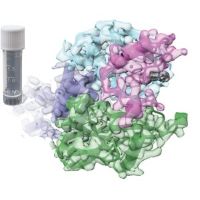Specification
| Description | Recombinant protein from the full-length sequence of Homo sapiens zinc finger protein 22 (ZNF22) (NM_006963). |
| Organism | Homo sapiens (Human) |
| Expression Host | Human Cells |
| Tag Info | His or DYKDDDDK. Please contact us if you need further information or require specific designed tag. |
| Purity | Greater than 90% by SDS-PAGE gel |
| Uniprot ID | P17026 |
| Entry Name | ZNF22_HUMAN |
| Gene Names | ZNF22 KOX15 KROX26 |
| Alternative Gene Names | KOX15 KROX26 |
| Alternative Protein Names | Zinc finger protein 22 (Zinc finger protein KOX15) (Zinc finger protein Krox-26) |
| Application | Antigens, Western, ELISA and other in vitro binding or in vivo functional assays, and protein-protein interaction studies; For research & development use only! |
| Buffer | Purified protein formulated in a sterile solution of PBS buffer, pH7.2, without any preservatives |
| Endotoxin | Endotoxin level is < 0.1 ng/µg of protein (<1EU /µg) |
| Length | 224 |
| Molecular Weight(Da) | 25915 |
| Protein Sequence | (The sequence of expressed protein may have some variation from the sequence shown below. Please contact us for the exact sequence.) MRLAKPKAGISRSSSQGKAYENKRKTGRQRQKWGMTIRFDSSFSRLRRSLDDKPYKCTECEKSFSQSSTLFQHQKIHTGKKSHKCADCGKSFFQSSNLIQHRRIHTGEKPYKCDECGESFKQSSNLIQHQRIHTGEKPYQCDECGRCFSQSSHLIQHQRTHTGEKPYQCSECGKCFSQSSHLRQHMKVHKEEKPRKTRGKNIRVKTHLPSWKAGTGRKSVAGLR |
Background
| Function | FUNCTION: Binds DNA through the consensus sequence 5'-CAATG-3'. May be involved in transcriptional regulation and may play a role in tooth formation (By similarity). {ECO:0000250}. |
| Pathway | |
| Protein Families | Krueppel C2H2-type zinc-finger protein family |
| Tissue Specificity | In the embryo, expressed in developing craniofacial structures including dental epithelium of maxillary molar tooth organs, tongue epithelium and muscle, and craniofacial bone osteoblasts. In the adult, expressed in mesoderm-derived tissues such as skeletal muscle, heart, kidney and liver. Intermediate expression in spleen, thymus and brain. Low levels in endoderm-derived tissues such as intestine and colon. {ECO:0000269|PubMed:14630903}. |
QC Data
| Note | Please contact us for QC Data |
| Product Image (Reference Only) |  |

